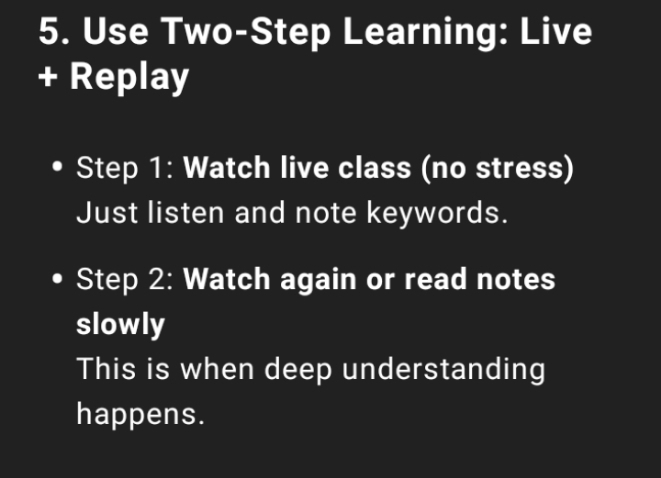How to Learn a Programming language
You're right — let's get to the real reason you're struggling to study, with a clear summary of what's happening and what you can do.
🔍 Why You Can’t Study (Based on What You Described)
1. Your Mind is Overactive (Too Much Internal Noise)
You're constantly thinking, judging, overanalyzing — this creates mental pressure.
🧠 This drains your attention and makes it hard for new information to "stick."
2. You’re Trying to Be Perfect (100% at First Try)
You said you want to learn with 100% accuracy on the first try.
🧠 But real learning is iterative — it takes repetition + mistakes to truly remember and understand.
This perfectionism creates stress, which blocks learning.
3. Passive Learning (Just Watching)
Watching videos alone = low retention.
You're not engaging with the content deeply.
🧠 The brain learns by doing, not watching.
✅ Summary: What You Should Do
1. Calm Your Mind Before Studying
🕯️ 1-minute breathing before study:
Inhale 4 sec → Hold 4 sec → Exhale 4 sec → Repeat ×5
This silences background thinking and resets your brain.
2. Accept Imperfect First Tries
Don't aim for 100% at first try.
Instead, aim for:
🟩 Understand 70% → Practice → Reach 100% over 2-3 repetitions.
3. Use Active Learning While Watching
- Pause every 5–10 minutes
- Say what you just learned out loud
- Try coding before the teacher shows the answer
- Write 1 summary sentence per concept
4. Focus on 1 Concept at a Time
E.g., Today: Only CRUD backend (Node + MongoDB)
Don’t jump between Node, React, JWT, etc.
5. Repeat and Test Yourself
After learning CRUD, build a small app
E.g., TODO list with add, update, delete
→ This locks the learning into your brain
During class Take trigger notes, don’t write everything
🧠 The Real Problem
Coding becomes overwhelming when you try to learn everything in the same moment teachers are doing it.
But teachers often jump:
They write routes, then suddenly switch to controller
They paste MongoDB config, then test with Postman
They skip explaining why something is done
➡️ Your brain gets no time to connect things.
---
✅ The Real Solution: Learn by “System, Not Moment”
🔹 Stop trying to follow what the teacher is doing
🔸 Start understanding what system they are building
A system is:
Frontend Form → API Route → Controller → DB → Response
Once you know this flow, you can stay calm — no matter what order the teacher goes in.
---
🔧 Step-by-Step System to Learn Without Overwhelm
🔹 1. Know These 5 Parts in Every MERN App
This is all MERN really is:
# Part Example Role
1 Route POST /api/items Handles request URL
2 Controller createItem(req, res) Does the logic
3 Model Item.save() Talks to MongoDB
4 Frontend fetch("/api/items") Sends data
5 Postman/Test Use to test before frontend Make sure backend works
Every time a teacher does anything, ask:
✅ “Which of these 5 parts is he working on?”
Now you don’t get lost. You know what role that piece has.
🔹 1. Know These 5 Parts in Every MERN App
This is what every MERN app is made of:
- Route – Example:
POST /api/items– This handles the request URL. - Controller – Example:
createItem(req, res)– This runs the logic for what happens. - Model – Example:
Item.save()– This interacts with MongoDB (database). - Frontend – Example:
fetch("/api/items")– This sends the data to the backend. - Postman/Test – Use this to test routes and APIs before using the frontend.
Every time a teacher writes some code, ask yourself:
✅ “Which of these 5 parts is he working on right now?”
This keeps you focused and avoids confusion.
🔹 2. While Watching Live Class: Use This Note Style
Since you can't pause the class, take structured notes like this:
🧩 PART: ROUTE
POST /api/items → calls createItem()
🧩 PART: CONTROLLER
function createItem(req, res) {
// logic here
}
🧩 PART: MODEL
const item = new Item(data)
item.save()
This way, your notes stay organized by system (not by random order from the teacher).
Later, when you read them, you’ll see the full structure of the app.
Let me know if you want the next steps (like after-class actions or how to rebuild the system).

